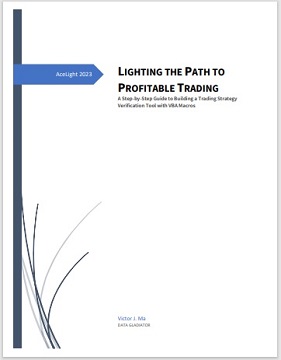Navigating the Waves of Success: Exploring Stock Day Trading Strategies
|
|
Welcome to our blog on stock day trading strategies, where we will explore
various techniques, insights, and examples to help you understand how to
become a successful day trader. Day trading can be a lucrative venture, but
it requires discipline, knowledge, and a well-defined strategy to navigate
the fast-paced world of stock markets. In this article, we will delve into
the essential strategies, tools, and mindset needed to excel in stock day
trading.
1. What is Day Trading?
Day trading refers to the
practice of buying and selling financial instruments, such as stocks, within
the same trading day. Unlike long-term investing, day traders aim to profit
from short-term price fluctuations in the market. Day traders typically
close their positions by the end of the trading day, avoiding overnight
exposure to potential market risks.
2. Why is Day Trading Popular?
Day trading has gained popularity due to several factors. Firstly,
advancements in technology have made it easier for individuals to access
real-time market data and execute trades swiftly. Additionally, the allure
of potentially generating significant profits in a short period attracts
many traders. However, it's crucial to note that day trading also involves
risks and requires a solid strategy to be consistently profitable.
3.
Essential Day Trading Strategies:
a. Momentum Trading: Momentum
trading focuses on identifying stocks with strong price momentum and joining
the trend. Traders look for stocks exhibiting significant price movement,
increased trading volume, and positive news catalysts. By entering trades in
the direction of the momentum, day traders aim to profit from continued
price appreciation. Proper risk management and the ability to quickly adapt
are crucial in momentum trading.
b. Breakout Trading: Breakout
trading involves identifying key levels of support or resistance and
entering a trade when the price breaks out of that range. Traders monitor
stocks that have been consolidating within a specific range and look for a
breakout above resistance or below support levels. Breakout traders often
use technical indicators to confirm the strength of a breakout and place
their trades accordingly.
c. Scalping: Scalping is a strategy that
focuses on making small profits from frequent, rapid trades. Scalpers aim to
capitalize on short-term price fluctuations by entering and exiting
positions within seconds to minutes. This strategy requires quick
decision-making, excellent timing, and the ability to manage multiple trades
simultaneously. Traders often utilize charts with small time frames and rely
on technical indicators to identify short-term trends.
d. Range
Trading: Range trading involves identifying stocks that are trading within a
well-defined price range. Traders aim to buy at support levels and sell at
resistance levels. This strategy relies on the assumption that the price
will continue to bounce between these levels until a significant breakout or
breakdown occurs. Range traders often employ technical indicators, such as
oscillators, to identify overbought or oversold conditions within the range.
4. Technical Analysis Tools for Day Trading:
a. Moving Averages:
Moving averages help smooth out price data and identify trends. Traders
often use the 20-day and 50-day moving averages to determine the overall
trend. Crossovers between moving averages can indicate potential entry or
exit points.
b. Relative Strength Index (RSI): The RSI is a momentum
oscillator that measures the speed and change of price movements. Traders
use the RSI to identify overbought or oversold conditions, which can signal
potential reversals or continuation of trends.
c. Bollinger Bands:
Bollinger Bands consist of a moving average and two standard deviation
lines. They help identify periods of high or low volatility. When the price
reaches the upper band, it may indicate overbought conditions, while
reaching the lower band may suggest oversold conditions.
d. Volume
Analysis: Analyzing trading volume can provide insights into the strength of
price movements. An increase in volume during a price breakout or breakdown
can validate the strength of the move, while low volume during
consolidations may suggest a lack of conviction.
5. Risk Management
in Day Trading:
a. Setting Stop Loss Orders: A stop loss order is a
predetermined price level at which a trader exits a trade to limit potential
losses. Placing stop loss orders is crucial to manage risk and protect
capital. Traders should determine their stop loss levels before entering any
trade and stick to their predefined rules.
b. Determining Position
Size: Position sizing refers to the number of shares or contracts a trader
allocates for a particular trade. By determining an appropriate position
size based on risk tolerance and the distance to the stop loss level,
traders can ensure that a single trade's potential loss does not exceed a
predetermined percentage of their total trading capital.
c. Using
Risk-Reward Ratios: A risk-reward ratio compares the potential profit of a
trade to the potential loss. A favorable risk-reward ratio ensures that the
potential profit is significantly higher than the potential loss, allowing
traders to maintain profitability even with a lower win rate.
6.
Building a Day Trading Plan:
a. Pre-market Analysis: Before the
market opens, traders should analyze news, earnings reports, and overnight
price movements to identify potential opportunities and plan their trades
accordingly.
b. Identifying Trade Opportunities: Based on pre-market
analysis and technical indicators, traders should identify stocks that meet
their preferred day trading strategies, such as momentum plays, breakouts,
or range-bound setups.
c. Entry and Exit Points: Determining precise
entry and exit points is crucial for executing trades effectively. Traders
should establish clear criteria for entering trades and define profit
targets or trailing stop loss levels to lock in gains or minimize losses.
d. Review and Evaluation: After the trading day concludes, it's
essential to review and evaluate the trades executed. By analyzing the
outcomes and identifying areas for improvement, traders can refine their
strategies and enhance their performance over time.
7. Embracing
Discipline and Emotional Control:
Successful day traders understand
the importance of discipline and emotional control. Emotions such as fear
and greed can cloud judgment and lead to impulsive decisions. Establishing a
trading routine, adhering to predefined rules, and managing emotions are
vital to consistent profitability.
8. Real-Life Examples of
Successful Day Trading Strategies:
a. Example 1: Breakout Trading on
a Stock Earnings Announcement: Suppose a trader identifies a stock that has
been consolidating within a range ahead of its earnings announcement. They
set a buy order above the resistance level, anticipating a potential
breakout if the earnings report exceeds market expectations. If the breakout
occurs, the trader can ride the upward momentum for a profitable trade.
b. Example 2: Scalping Strategy on Intraday Price Swings: A scalper
monitors a highly liquid stock with significant intraday price swings. They
enter short-term trades, aiming to capture small gains by buying at the
support level and selling near resistance. This strategy relies on quick
execution and taking advantage of short-term price volatility.
c.
Example 3: Range Trading During Sideways Market Conditions: In a sideways
market, a range trader identifies stocks with well-defined support and
resistance levels. They buy near support and sell near resistance, taking
advantage of the price bouncing between these levels. By employing proper
risk management techniques, range traders can profit from the predictable
price patterns.
 Note: it's crucial to thoroughly
test any trading strategy before using it in live markets. This means
conducting both back-testing and forward-testing to evaluate the strategy's
effectiveness and identify potential flaws or weaknesses. If
you want to succeed in the stock market, make sure to prioritize testing
before putting your capital at risk. For more information, Click
LIGHTING THE PATH TO PROFITABLE TRADING: A Step-by-Step Guide to Building a Trading Strategy Verification Tool with VBA Macros to get the whole tutorial handbook for free! Note: it's crucial to thoroughly
test any trading strategy before using it in live markets. This means
conducting both back-testing and forward-testing to evaluate the strategy's
effectiveness and identify potential flaws or weaknesses. If
you want to succeed in the stock market, make sure to prioritize testing
before putting your capital at risk. For more information, Click
LIGHTING THE PATH TO PROFITABLE TRADING: A Step-by-Step Guide to Building a Trading Strategy Verification Tool with VBA Macros to get the whole tutorial handbook for free!
And click Free Trial to download strategies testing tools, all for a 30-day Free Trial.
Click on Subscription to order more strategies testing tools to help your stock trading.
Conclusion:
Mastering stock day trading strategies
requires a combination of technical analysis skills, risk management
techniques, and emotional discipline. By understanding and implementing
momentum trading, breakout trading, scalping, and range trading strategies,
traders can enhance their chances of consistent profitability. It is
essential to use technical analysis tools such as moving averages, RSI,
Bollinger Bands, and volume analysis to make informed trading decisions.
Furthermore, traders should prioritize risk management by setting stop
loss orders, determining position sizes, and evaluating risk-reward ratios.
Developing a comprehensive day trading plan, conducting pre-market analysis,
identifying trade opportunities, and reviewing trades are critical steps
toward success.
Remember, successful day trading is a continuous
learning process that requires practice, patience, and adaptability. By
studying real-life examples and embracing discipline and emotional control,
you can navigate the dynamic world of day trading and increase your chances
of achieving profitable trades.
|


|

Free Tutorial
Share
|
|
|
|